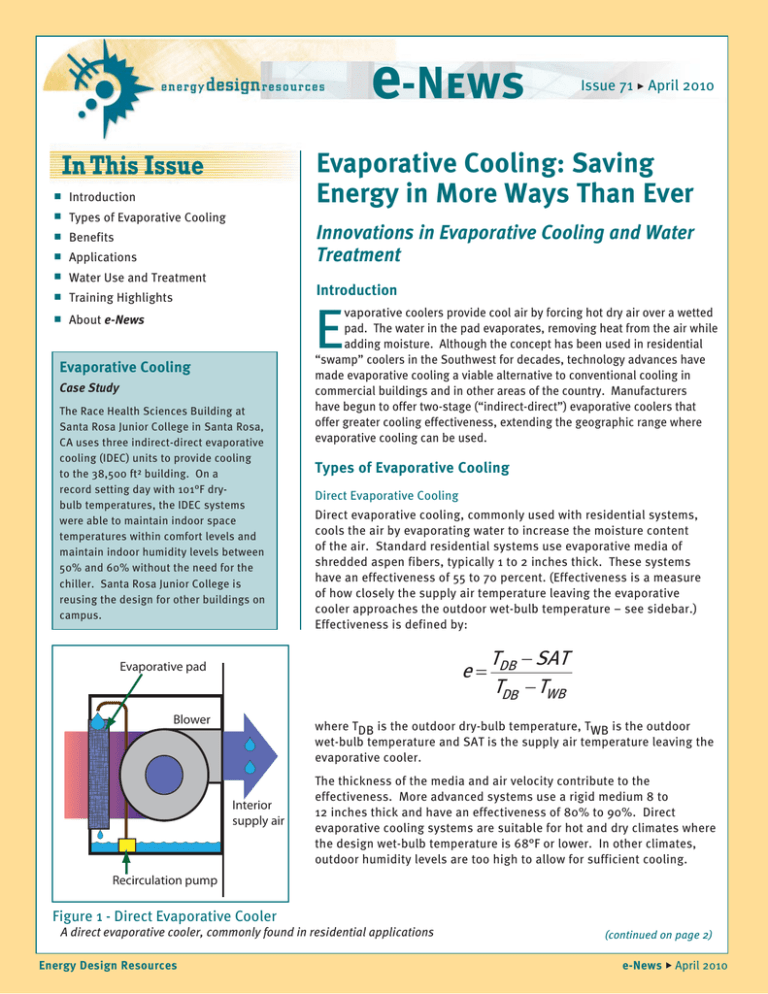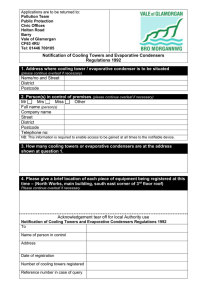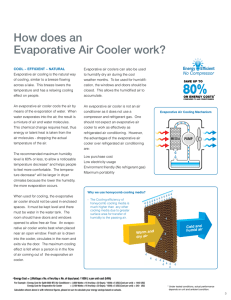
e-News
Issue 71 April 2010
Evaporative Cooling: Saving
Energy in More Ways Than Ever
Introduction
Types of Evaporative Cooling
Benefits
Applications
Water Use and Treatment
Training Highlights
About e-News
Innovations in Evaporative Cooling and Water
Treatment
Introduction
vaporative coolers provide cool air by forcing hot dry air over a wetted
pad. The water in the pad evaporates, removing heat from the air while
adding moisture. Although the concept has been used in residential
“swamp” coolers in the Southwest for decades, technology advances have
made evaporative cooling a viable alternative to conventional cooling in
commercial buildings and in other areas of the country. Manufacturers
have begun to offer two-stage (“indirect-direct”) evaporative coolers that
offer greater cooling effectiveness, extending the geographic range where
evaporative cooling can be used.
E
Evaporative Cooling
Case Study
The Race Health Sciences Building at
Santa Rosa Junior College in Santa Rosa,
CA uses three indirect-direct evaporative
cooling (IDEC) units to provide cooling
to the 38,500 ft² building. On a
record setting day with 101°F drybulb temperatures, the IDEC systems
were able to maintain indoor space
temperatures within comfort levels and
maintain indoor humidity levels between
50% and 60% without the need for the
chiller. Santa Rosa Junior College is
reusing the design for other buildings on
campus.
Types of Evaporative Cooling
Direct Evaporative Cooling
Direct evaporative cooling, commonly used with residential systems,
cools the air by evaporating water to increase the moisture content
of the air. Standard residential systems use evaporative media of
shredded aspen fibers, typically 1 to 2 inches thick. These systems
have an effectiveness of 55 to 70 percent. (Effectiveness is a measure
of how closely the supply air temperature leaving the evaporative
cooler approaches the outdoor wet-bulb temperature – see sidebar.)
Effectiveness is defined by:
Evaporative pad
e
Blower
TDB SAT
TDB TWB
where TDB is the outdoor dry-bulb temperature, TWB is the outdoor
wet-bulb temperature and SAT is the supply air temperature leaving the
evaporative cooler.
Interior
supply air
The thickness of the media and air velocity contribute to the
effectiveness. More advanced systems use a rigid medium 8 to
12 inches thick and have an effectiveness of 80% to 90%. Direct
evaporative cooling systems are suitable for hot and dry climates where
the design wet-bulb temperature is 68°F or lower. In other climates,
outdoor humidity levels are too high to allow for sufficient cooling.
Recirculation pump
Figure 1 - Direct Evaporative Cooler
A direct evaporative cooler, commonly found in residential applications
Energy Design Resources
(continued on page 2)
e-News April 2010
moisture. The air is then passed through a direct stage,
which cools the air further while adding moisture. IDEC
systems typically have an effectiveness of 100% to
115%, cooling the air to a temperature slightly below the
outdoor air wet-bulb temperature (see sidebar).
Indirect Evaporative Cooling
Indirect evaporative cooling uses an air to air heat
exchanger to remove heat from the primary air stream
without adding moisture. In one configuration, hot
dry outside air is passed through a series of horizontal
tubes that are wetted on the outside. A secondary air
stream blows over the outside of the coils and exhausts
the warm, moist air to the outdoors. The outside air is
cooled without adding moisture as it passes through
the tubes. Indirect evaporative cooling typically has an
effectiveness of 75%.
For commercial systems, indirect-direct systems are
often coupled with a conventional DX cooling stage to
meet cooling demand during hot and humid outdoor
conditions (when outdoor air dry-bulb temperatures
exceed 70°F). Since the systems use 100% outside air
for cooling, they can also be paired with heat recovery to
capture some of the energy that is lost in the exhaust air
stream and reduce the ventilation cooling load.
Another system type that is used in residential and light
commercial applications uses the Maisotsenko cycle,
which uses a cross-channel heat exchanger that cools
the air incrementally over a large number of stages.
Systems using the Maisotsenko cycle can have wet-bulb
effectiveness values of 85% to over 100% (cooling the
supply air to below the wet-bulb temperature). While
the greater number of air passes increases the pressure
drop and the required fan power, the high effectiveness
extends the geographic range where the indirect
evaporative cooler can fully meet the cooling demand.
IDEC systems used in arid climates (with a design wetbulb temperature of 66°F or lower) can have power
consumption as low as 0.22 kW/ton, much lower than
compressor-based cooling which can have power
consumption on the order of 1 kW/ton. However, in more
humid climates indirect-direct systems have less power
reduction and energy savings.
Evaporative Pre-Cooling
Evaporative pre-coolers reduce air conditioner load
by cooling the air that surrounds air conditioner
condensers. Since the cooler, moister air is passed
over the condenser, the moisture is not added to the
space. The cooler air passed across the condenser coil
improves heat transfer efficiency, allowing the system to
run efficiently during hot outdoor conditions. Also, since
peak cooling capacity is increased it may be possible
to downsize equipment. Pre-coolers are generally only
used in hot and dry climates on large units of 40 tons or
greater.
Two Stage Systems
Indirect cooling is often paired with a second direct
evaporative cooling stage, to cool the supply air further
while adding some moisture to the supply air. Such
two-stage systems (referred to as indirect-direct or IDEC
systems) can meet the entire cooling load for many
buildings in arid to semi-arid climates. IDEC systems
provide cooler supply air at a lower relative humidity
than direct evaporative coolers. The first indirect stage
cools the supply air without increasing humidity. Since
the air is cooled it has a reduced capacity to hold
Evaporative Cooling Effectiveness
The cooling capacity of an evaporative cooler is limited by the outdoor wet-bulb temperature. The following table
shows supply air temperatures typically achievable with direct and indirect-direct (IDEC) evaporative coolers.
City
Sacramento
Palm Springs
Los Angeles
San Diego
San Jose
San Francisco
Design DB
100.4
111.2
83.7
84.1
92.3
83
Design WB
Direct Supply Air
Temperature
70.7
72.5
64.3
67.7
66.9
63
75.2
78.3
67.2
70.2
70.7
66.0
Indirect-Direct Supply Air
Temperature
67.7
68.6
62.4
66.1
64.4
61.0
Assumptions: weather data is ASHRAE 0.4% design dry-bulb and mean coincident wet-bulb; assumed effectiveness of
85% for direct and 110% for indirect-direct evaporative coolers.
(continued on page 3)
Energy Design Resources
2
e-News April 2010
Evaporatively Cooled Condensers
Evaporative pad
Vented
moist air
Exterior air
Exterior air
Blower
Evaporative
heat exchanger
Interior
supply air
Recirculation pump
Figure 2 - Indirect-Direct Evaporative Cooler (IDEC)
Typical air-cooled condensers used
with direct-expansion (DX) systems
lose efficiency significantly during hot
outdoor conditions. Evaporatively-cooled
condensers allow heat to be rejected
at a much cooler temperature, which
allows the system to operate at a much
higher efficiency during peak conditions.
Peak demand can be reduced by 40% in
comparison to air-cooled DX systems.
These systems provide the greatest benefit
in climates that have significant hours of
cooling during outdoor temperatures of
95°F or greater. Although these systems are
relatively common in larger cooling plants,
products are now available for residential
and light commercial applications.
Controls
Advanced features on evaporative coolers recently introduced to the market include variable air volume control.
Some units use variable-speed drives, or two-speed or electrically commutated motors for smaller units, to control the
space temperature to the desired setpoint. Lower air velocity increases heat transfer effectiveness and significantly
reduces system fan power.
An advanced feature not commonly available on evaporative coolers would include the use of sensors to monitor
system performance. Temperature and humidity measurements would allow for an estimate of system effectiveness.
Static pressure gauges that measure pressure drop across the media can also be used to determine when
maintenance of the media is required.
Due to the higher air temperatures than traditional air conditioning systems, much more air must be used to provide
the necessary cooling. As it is generally 100% outside air, provisions must
be made for venting the air to the outside without requiring the opening
Related Resources
of windows. With residential applications, vents installed in the ceiling
Assessment of Market-Ready Evaporative
(known as an “up duct”) are designed to open when the home is positively
Technologies for HVAC Applications, New
pressurized. Sufficient attic ventilation must be provided to then exhaust
Buildings Institute Report, 2006
the ventilation air to the outside.
http://www.newbuildings.org/documentlibrary
Benefits
Evaporative cooling systems have a number of benefits. First and
foremost, they use only a fraction of the energy of typical compressorbased cooling systems. Highly efficient evaporative cooling systems can
reduce energy use by 70%. (The actual savings will vary with the type of
evaporative system and the climate.) For dry climates where evaporative
cooling can meet the entire load, they dramatically reduce peak demand.
When evaporative cooling is used with supplemental DX cooling it can
reduce the DX cooling required. Moreover, since they use 100% outside
air for cooling, the right evaporative cooling system can provide good
indoor air quality.
Residential direct evaporative cooling systems cost much less than
DX cooling systems. However, two-stage units used for commercial
applications can cost as much as or more than conventional cooling
systems, since they are often custom-built. With the water pump and fan
as the primary serviceable components, evaporative cooling systems can
have low maintenance costs. Southern California Edison offers rebates of
$300 to $600 for qualifying evaporative coolers.
Southwest Energy Efficiency Project,
SWEEP / WCEC Workshop Summary,
Workshop on Modern Evaporative Cooling
Technologies, 2007
http://www.swenergy.org/events/
evaporative/Summary.pdf
Advanced Evaporative Cooling White
Paper, Davis Energy Group, 2004
http://www.energy.ca.gov/
reports/2004-04-07_500-04-016_AT1.PDF
ASHRAE Handbook, HVAC Systems and
Equipment, 2008.
http://www.ashrae.org/publications/
(continued on page 4)
Energy Design Resources
3
e-News April 2010
Applications
About e-News
D
on’t miss future issues—to sign up
for a free email subscription, please
visit www.energydesignresources.com.
Send letters to the editor, suggestions on
topics for future issues, or other comments to
enews@energydesignresources.com.
e-News is published by Energy Design
Resources (www.energydesignresources.
com), an online resource center for
information on energy efficiency design
practices in California.
Savings By Design
(www.savingsbydesign.com) offers design
assistance and incentives to design teams
and building owners in California to
encourage high-performance nonresidential
building design and construction.
Energy Design Resources and Savings
By Design are funded by California utility
customers and administered by Pacific Gas
and Electric Company, Sacramento Municipal
Utility District, San Diego Gas and Electric,
Southern California Edison and Southern
California Gas Company, under the auspices
of the California Public Utilities Commission.
Evaporative cooling has a number of applications in the residential
and light commercial markets. Direct evaporative cooling is primarily
used in very hot and dry regions and residential markets. Indirectdirect evaporative cooling can be used throughout most of California.
Since 100% outdoor air is used, it has significant secondary benefits in
applications with high outdoor air requirements such as classrooms.
Recently, the more advanced indirect and indirect-evaporative coolers
have been developed for the residential and light commercial market.
Indirect evaporative cooling can be coupled with conventional DX cooling
to lower refrigeration loads. A system using indirect evaporative cooling
with DX cooling can have a lower total cooling load than a recirculation
system using only DX cooling. Sutter Warrick Hospital in Santa Rosa,
California used this configuration to provide improved indoor air quality
in conjunction with reduced cooling load.
Water Use and Water Treatment
Water is used with evaporative systems to both replace the evaporated
water and to purge dissolved minerals that accumulate as water
evaporates. Residential systems typically use 5 to 10 gallons of water
per hour of operation. Most high efficiency units meet water use levels
recommended by the California Energy Commission (0.15 gpm/ton or
lower). This water consumption is partially offset by the reduced power
consumption of evaporative cooling units, since the reduced load reduces
water consumption at the power plant.
Water treatment is a concern, especially for areas of the desert southwest
that have hard water. Mineral deposits will accumulate in the sump and
eventually cause scale on the pads. One option is a bleed-off system, which diverts a small amount of water out of
the distribution basin to dilute mineral concentrations. The bleed rate depends upon water hardness and airborne
contaminant levels and can range from 5% to 100% of the evaporation rate. A blow-down system will periodically
dump water from the sump while the cooler is in operation. The discharged water can be used to water gardens.
Blow-down systems have an advantage over bleed-down systems in that they discharge accumulated dirt and debris
that collects at the bottom of the sump, and they often use less water than continuous bleed systems. A third option
is water treatment. Water treatment is often recommended for systems with rigid media due to high replacement
costs. Other treatment mechanisms include electromagnetic, electrostatic, catalytic and mechanical.
Training Highlights
California utilities offer outstanding educational opportunities
that focus on the design, construction and operation of energyefficient buildings. Listed here are a few of the many upcoming
classes and events; for complete schedules, visit each utility’s
website.
Green Buildings - Proven Emerging Technologies
Emerging efficient HVAC systems for various types of buildings
will be presented in terms of advantages and disadvantages.
HVAC systems to be discussed include chilled beam, positive
displacement, variable refrigerant flow, underground air
distribution, and VAV systems. San Diego Energy Resource
Center. May 19, 8:00am to 12:00pm, San Diego. https://
seminars.sdge.com
Compressorless Cooling
Learn about the design and installation of compressorless cooling
technologies. Topics to be covered include whole house cooling
fans, single-stage direct evaporative cooling, indirect/direct twostage evaporative cooling, residential economizers, and utility
rebates for whole house cooling fans and evaporative coolers.
Pacific Energy Center. April 15, 9:00am to 4:30pm, Stockton
ETC. http://www.pge.com/mybusiness/edusafety/training/pec/
classes/
Evaporative Cooling for Commercial and Industrial Facilities
Evaporative cooling will be explored as an energy efficient
and cost effectie means of cooling commercial and industrial
buildings. Participants will learn about the technology, climate
zone, economic considerations, maintenance, and water treatment
related to evaporative cooling. http://www.sce.com/ECR/
© 2004–2010 Energy Design Resources. All Rights Reserved.
Energy Design Resources
4
e-News April 2010


